An asteroid the size of a football field came extremely close to the Earth last week, and scientists didn’t even know until after it passed us by. Asteroid 2002 MN is 100 metres in diameter and passed by us at a distance of only 120,000km, less than one-third the distance from the Earth to the Moon. This is one of the closest near-misses ever recorded of a spacerock this size; had it actually struck the planet it would have cause considerable destruction and loss of life.
Endeavour Lands in California
After two extra days in space, Endeavour finally touched down at Edwards Air Force Base in California on Wednesday. The landing had been delayed because of thunderstorms at the Florida landing strip. During the shuttle’s 14 days in space, the astronauts delivered a new crew to the International Space Station and performed three spacewalks to install new hardware. The shuttle will now be mounted onto the back of a specially modified 747 and flown back to Florida to prepare for its next launch.
Endeavour in Space Another Day
Once again NASA postponed the landing of the space shuttle Endeavour because of foul weather in both Florida and California. The next opportunity will be on Wednesday, when the shuttle will try to land at Cape Canaveral at 1452 GMT (10:52am EDT). There’s one more window in Florida and three at California’s Edwards Air Force Base. The shuttle has enough supplies to remain in orbit until Thursday.
French Astronaut Gets Government Position
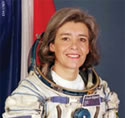
Image credit: ESA
Claudie Haigner?, an astronaut with the European Space Agency, has been appointed to the post of Minister for Research and New Technologies in the French government. She joined the European Astronaut Corps in 1999 and has been to space twice on board Russian Soyuz spacecraft – she was the first European woman to visit the International Space Station in 2001.
Claudie Haigner?, the ESA astronaut, has been appointed to the post of Minister for Research and New Technologies in the French government announced yesterday.
Claudie Haigner?, 45, with an outstanding ‘cursus honoris’, a doctor with a specialisation in rheumatology and a Ph.D in neurosciences, was selected in 1985 as a candidate astronaut by the French space agency, CNES. She has played a prominent role in the development of scientific applications of manned spaceflight and in fostering scientific relations with Russia. Mrs Haigner? is a permanent member of the French Academy of Technology and holds the honours of Officier de la L?gion d’Honneur and Chevalier de l’Ordre National du M?rite.
In 1999 she joined the European Astronaut Corps of the European Space Agency. She has taken part in two space missions with the Russians, ‘Cassiop?e’ in August 1996 and ‘Androm?de’ in October 2001. She was the first woman to qualify as a Soyuz Return Commander (July 1999), responsible for the three-person Soyuz capsule during a re-entry from space, and was the first European woman to visit the International Space Station (October 2001).
ESA’s Director General, Antonio Rodot?, expressed delight at this appointment, “In our ‘space world’ Claudie Haigner? has demonstrated really outstanding capabilities as a scientist as well as an astronaut during her time with us. This appointment honours the European Space Agency and puts Mrs Haigner? in a key position to shape the future of Europe’s science and technology. I wish her all the best in her new responsibilities.”
Original Source: ESA News Release
View of Colorado Fire from Space
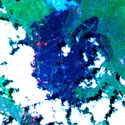
Image credit: NASA
A new photo released from NASA’s Terra spacecraft shows the huge swath of destruction caused by the enormous fire in Colorado. The fire started on June 8, and has gone on to destroy more than 40,000 hectares. The image was acquired using Terra’s Advanced Spaceborne Thermal Emission and Reflection Radiometer (Aster), one of five Earth imaging instruments on board the spacecraft. This photo was taken on morning of Sunday, June 16.
Thousands of acres of burned vegetation, along with recent hotspots, are visible in a new image of Colorado’s worst forest fire taken by NASA’s Advanced Spaceborne Thermal Emission and Reflection Radiometer (Aster).
Started on June 8, the Hayman forest fire continues to burn in the Pike National Forest, 57 kilometers (35 miles) south-southwest of Denver, Colo. According to the U.S. Forest Service, the fire has consumed more than 100,000 acres.
The image is available at:
http://www.jpl.nasa.gov/images/earth/usa/west.html.
Acquired Sunday morning, June 16, 2002, the Aster image shows active fires in red. The dark blue area is burned vegetation, and the green areas are healthy vegetation. Clouds are white. The blue cloud at the top center is smoke. The image covers an area of 32.2 by 35.2 kilometers (20 by 21.8 miles).
Aster is one of five Earth-observing instruments launched in December 1999 on NASA’s Terra satellite. With its 14 spectral bands from the visible to the thermal infrared wavelength region and its high spatial resolution of 15 to 90 meters (about 50 to 300 feet), Aster will image Earth for the next six years to map and monitor the planet’s changing surface. Japan’s Ministry of Economy, Trade and Industry built the instrument. NASA’s Jet Propulsion Laboratory, Pasadena, Calif., is responsible for the American portion of the joint U.S./Japan science team that validates and calibrates the instrument and the data products.
Original Source: NASA/JPL News Release
Write Your Name on an Asteroid?
A Japanese spacecraft will give people an opportunity to land their name on an asteroid. Due for launch near the end of this year, the MUSES-C spacecraft will meet up with asteroid 1998 SF36 when it crosses the Earth’s orbit in 2005. It will land on the asteroid, collect samples which it will later return to Earth. As part of its mission, the spacecraft will deposit an aluminium foil sheet containing the names of hundreds of thousands of space enthusiasts. If you want to get your name on board, you have until July 5th.
Thunderstorms Delay Shuttle Landing
Flight controllers decided to wave two landing attempts of the space shuttle Endeavour on Monday because of thunderstorms threatening the Cape Canaveral landing area. The shuttle will try again on Tuesday, but forecasters are predicting poor weather then too. Alternatively, the shuttle can land at Edward’s Air Force Base in California; however, it’s a more expensive option as Endeavour will need to be returned to Florida. The first landing attempt on Tuesday is scheduled for 1555 GMT (11:55am EDT).
New Planetary System has Familiar Feel
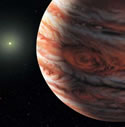
Image credit: NASA
Planet hunters have discovered a new extrasolar system that looks remarkable like our own Solar System. Until now, planets orbiting around other stars have had elongated and eccentric orbits, but a planet orbiting around 55 Cancri has almost the same distance as our own Jupiter (although, it does have 3.5-5 times the mass). The team of astronomers also announced an additional 13 new planets on the same day, bringing the total number of known planets outside our Solar System to over 90.
After 15 years of observation and a lot of patience, the world’s premier planet-hunting team has finally found a planetary system that reminds them of our own home solar system.
Dr. Geoffrey Marcy, astronomy professor at the University of California, Berkeley, and astronomer Dr. Paul Butler of the Carnegie Institution of Washington, Washington, D.C., today announced the discovery of a Jupiter-like planet orbiting a Sun-like star at nearly the same distance as the Jovian system orbits our Sun.
“All other extrasolar planets discovered up to now orbit closer to the parent star, and most of them have had elongated, eccentric orbits. This new planet orbits as far from its star as our own Jupiter orbits the Sun,” said Marcy. NASA and the National Science Foundation fund the planet-hunting team.
The star, 55 Cancri in the constellation Cancer, was already known to have one planet, announced by Butler and Marcy in 1996. That planet is a gas giant slightly smaller than the mass of Jupiter and whips around the star in 14.6 days at a distance only one-tenth that from Earth to the Sun.
Using as a yardstick the 93-million mile Earth-Sun distance, called an astronomical unit or AU, the newfound planet orbits at 5.5 AU, comparable to Jupiter’s distance from our Sun of 5.2 AU (about 824 million kilometers or 512 million miles). Its slightly elongated orbit takes it around the star in about 13 years, comparable to Jupiter’s orbital period of 11.86 years. It is 3.5 to 5 times the mass of Jupiter.
“We haven’t yet found an exact solar system analog, which would have a circular orbit and a mass closer to that of Jupiter. But this shows we are getting close, we are at the point of finding planets at distances greater than 4 AU from the host star,” said Butler. “I think we will be finding more of them among the 1,200 stars we are now monitoring.”
The team shared its data with Dr. Greg Laughlin, assistant professor of astronomy and astrophysics at the University of California, Santa Cruz. His dynamical calculations show that an Earth-sized planet could survive in a stable orbit between the two gas giants. For the foreseeable future, existence of any such planet around 55 Cancri will remain speculative.
“The existence of analogs to our solar system adds urgency to missions capable of detecting Earth-sized planets – first the Space Interferometry Mission and then the Terrestrial Planet Finder,” said Dr. Charles Beichman, NASA’s Origins Program chief scientist at the agency’s Jet Propulsion Laboratory, Pasadena, Calif.
“This planetary system will be the best candidate for direct pictures when the Terrestrial Planet Finder is launched later this decade,” said UC Berkeley astronomer Dr. Debra A. Fischer.
Marcy, Butler, Fischer and their team also announced a total of 13 new planets today, including the smallest ever detected: a planet circling the star HD49674 in the constellation Auriga at a distance of .05 AU, one-twentieth the distance from Earth to the Sun. Its mass is about 15 percent that of Jupiter and 40 times that of Earth. This brings the number of known planets outside our solar system to more than 90.
Discovery of a second planet orbiting 55 Cancri culminates 15 years of observations with the 3-meter (118-inch) telescope at Lick Observatory, owned and operated by the University of California. The team also includes Dr. Steve Vogt, University of California, Santa Cruz; Dr. Greg Henry, Tennessee State University, Nashville; and Dr. Dimitri Pourbaix, the Institut d’Astronomie et d’Astrophysique, Universit? Libre de Bruxelles.
The star 55 Cancri is 41 light years from Earth and is about 5-billion years old. Further data are needed to determine whether yet another planet is orbiting it, because the two known planets do not explain all the observed Doppler wobbling. One possible explanation is a Saturn-mass planet orbiting about .24 AU from the star.
Original Source: NASA/JPL News Release
Sea Launch Delivers PanAmSat to Orbit
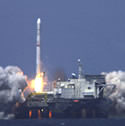
Image credit: Sea Launch
A Zenit-3SL successfully carried a PanAmSat’s Galaxy IIIC satellite into orbit on Saturday, marking the seventh launch from the floating Sea Launch platform. The three-stage rocket lifted off from the platform on Saturday at 2239 GMT (6:39pm EDT), and the spacecraft’s signal was detected a few minutes later, indicating a successful launch. The satellite will move to a geostationary orbit, where it will provide Internet, video, audio and data services to North America.
A Sea Launch rocket today successfully launched PanAmSat’s Galaxy IIIC satellite into orbit. Marking Sea Launch’s seventh successful mission, the three-stage rocket lifted off at 3:39:30 P.M. PDT from the Odyssey Launch Platform, positioned on the Equator. As planned, the spacecraft’s first signal was acquired shortly after spacecraft separation, at 4:47:00 p.m. PDT.
Built by Boeing Satellite Systems, the 10,692 lb. (4850 kg) 702 model spacecraft is designed for a 15 year lifespan in Geostationary Orbit. The satellite will provide Internet, video, audio and data services to the United States and Latin America.
“The launch of Galaxy IIIC commemorates the second time Sea Launch has successfully placed a PanAmSat satellite in orbit,” said Jim Maser, president of Sea Launch. “Our international team has recognized PanAmSat’s continued confidence in our launch performance and we look forward to working with them again in the near future.”
The Zenit-3SL vehicle lifted off from the Odyssey Launch Platform on schedule from the equatorial launch site at 154 degrees West Longitude. All systems performed nominally throughout the flight. The Block DM upper stage separated from the spacecraft about 1,385 miles above the Indian Ocean, 61 minutes after liftoff. Operators acquired a signal from Galaxy IIIC from a ground station in Western Australia. Galaxy IIIC will have a final position in Geostationary Orbit at 95 degrees West Longitude.
PanAmSat is a leading provider of global video and data broadcasting services via satellite. The company builds, owns and operates networks that deliver entertainment and information to cable television systems, TV broadcast affiliates, direct-to-home TV operators, telecommunications companies and corporations. Based in Wilton, Conn., PanAmSat has one of the world’s largest commercial geostationary satellite networks.
Sea Launch Company, LLC, based in Long Beach, Calif., provides reliable, cost-effective, heavy lift launch services for commercial satellite customers. The international members include Boeing (U.S.), Kvaerner (Norway), RSC Energia (Russia) and SDO Yuzhnoye / PO Yuzhmash (Ukraine). Established in 1995, Sea Launch has a current backlog of 17 firm launch contracts. As the world’s only services provider launching from the Equator, Sea Launch offers the optimal starting point for spacecraft heading to Geostationary Orbit. For additional information, visit the Sea Launch website at www.sea-launch.com.
Original Source: Boeing News Release
Hubble Reveals Retina Nebula
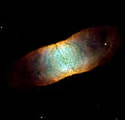
Image credit: Hubble
The most recently released photograph taken by the Hubble Space Telescope is of wispy nebula IC 4406, dubbed the “Retina Nebula”. The object is a ring of dust and gas around a dying star and is nearly perfectly symmetrical. One of the more interesting features is the lattice of dark lanes that crisscross the centre of the nebula, each of which is 160 astronomical units wide (1 AU is the distance from the Earth to the Sun). The photograph is a composite of images taken in June 2001 and January 2002.
A dying star, IC 4406, dubbed the “Retina Nebula” is revealed in this month’s Hubble Heritage image.
Like many other so-called planetary nebulae, IC 4406 exhibits a high degree of symmetry; the left and right halves of the Hubble image are nearly mirror images of the other. If we could fly around IC 4406 in a starship, we would see that the gas and dust form a vast donut of material streaming outward from the dying star. From Earth, we are viewing the donut from the side. This side view allows us to see the intricate tendrils of dust that have been compared to the eye’s retina. In other planetary nebulae, like the Ring Nebula (NGC 6720), we view the donut from the top.
The donut of material confines the intense radiation coming from the remnant of the dying star. Gas on the inside of the donut is ionized by light from the central star and glows. Light from oxygen atoms is rendered blue in this image; hydrogen is shown as green, and nitrogen as red. The range of color in the final image shows the differences in concentration of these three gases in the nebula.
Unseen in the Hubble image is a larger zone of neutral gas that is not emitting visible light, but which can be seen by radio telescopes.
One of the most interesting features of IC 4406 is the irregular lattice of dark lanes that criss-cross the center of the nebula. These lanes are about 160 astronomical units wide (1 astronomical unit is the distance between the Earth and Sun). They are located right at the boundary between the hot glowing gas that produces the visual light imaged here and the neutral gas seen with radio telescopes. We see the lanes in silhouette because they have a density of dust and gas that is a thousand times higher than the rest of the nebula. The dust lanes are like a rather open mesh veil that has been wrapped around the bright donut.
The fate of these dense knots of material is unknown. Will they survive the nebula’s expansion and become dark denizens of the space between the stars or simply dissipate?
This image is a composite of data taken by Hubble’s Wide Field Planetary Camera 2 in June 2001 by Bob O’Dell (Vanderbilt University) and collaborators and in January 2002 by The Hubble Heritage Team (STScI). Filters used to create this color image show oxygen, hydrogen, and nitrogen gas glowing in this object.
Original Source: Hubble News Release
